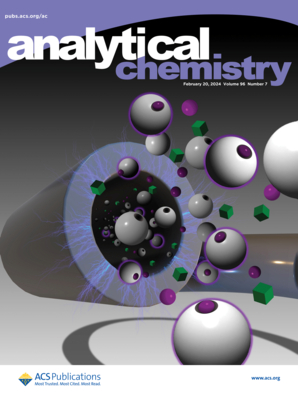质谱法研究食管癌类器官中挥发性有机物的特征。
IF 6.7
1区 化学
Q1 CHEMISTRY, ANALYTICAL
引用次数: 0
摘要
挥发物学是研究非侵入性生物标志物的一个新兴领域,通过检测挥发性有机化合物(VOCs)来识别食管癌(EC)具有重要的前景。本研究通过分析三维类器官和球体模型以及二维单层培养的挥发性有机化合物来研究EC细胞的共同特征。采用固相微萃取-气相色谱-质谱(SPME-GC-MS)非靶向法测定VOC谱。在类器官、球形和单层培养模型中,在EC和正常食管细胞(NE)之间分别鉴定出21、9和8种代谢差异的挥发性有机化合物。这三种模型之间的相关性分析揭示了EC的共同特征VOC: 2-甲基丁酸乙酯。该VOC在EC中显著增加,曲线下面积(AUC)在0.93 ~ 0.99之间,具有良好的诊断潜力。此外,EC和NE组织的转录组学数据分析揭示了EC组织中蛋白质降解和吸收的上调,支持了2-甲基丁酸乙酯来自该代谢途径异常的假设。本研究不仅为EC的鉴定提供了潜在的VOC生物标志物,而且为进一步阐明EC代谢紊乱的生化机制提供了科学依据,有可能促进气相活检技术在EC诊断中的发展。本文章由计算机程序翻译,如有差异,请以英文原文为准。
Investigation of Characteristic Volatile Organic Compounds in Esophageal Cancer Organoids by Mass Spectrometry.
Volatilomics, an emerging field in the study of noninvasive biomarkers, holds significant promise for identifying esophageal cancer (EC) through the detection of volatile organic compounds (VOCs). This study investigates common characteristic VOCs of EC cells by analyzing VOCs from three-dimensional organoid and spheroid models as well as two-dimensional monolayer cultures. The VOC profiles were measured by using solid-phase microextraction-gas chromatography-mass spectrometry (SPME-GC-MS) in an untargeted approach. In the organoid, spheroid, and monolayer culture models, 21, 9, and 8 metabolically differential VOCs were identified between EC and normal esophageal (NE) cells, respectively. Correlation analysis across these three models revealed a shared characteristic VOC of EC: ethyl 2-methylbutyrate. This VOC was markedly increased in EC, demonstrating excellent diagnostic potential with an area under the curve (AUC) ranging from 0.93 to 0.99. Furthermore, transcriptomic data analysis of EC and NE tissues revealed the upregulation of protein degradation and absorption in EC tissues, supporting the hypothesis that ethyl 2-methylbutyrate arises from abnormalities within this metabolic pathway. This study not only supplies potential VOC biomarkers for EC identification but also provides a scientific basis for further elucidating the biochemical mechanisms underlying EC metabolic disturbances, potentially facilitating the gaseous biopsy technique development for EC diagnosis.
求助全文
通过发布文献求助,成功后即可免费获取论文全文。
去求助
来源期刊

Analytical Chemistry
化学-分析化学
CiteScore
12.10
自引率
12.20%
发文量
1949
审稿时长
1.4 months
期刊介绍:
Analytical Chemistry, a peer-reviewed research journal, focuses on disseminating new and original knowledge across all branches of analytical chemistry. Fundamental articles may explore general principles of chemical measurement science and need not directly address existing or potential analytical methodology. They can be entirely theoretical or report experimental results. Contributions may cover various phases of analytical operations, including sampling, bioanalysis, electrochemistry, mass spectrometry, microscale and nanoscale systems, environmental analysis, separations, spectroscopy, chemical reactions and selectivity, instrumentation, imaging, surface analysis, and data processing. Papers discussing known analytical methods should present a significant, original application of the method, a notable improvement, or results on an important analyte.
 求助内容:
求助内容: 应助结果提醒方式:
应助结果提醒方式:


